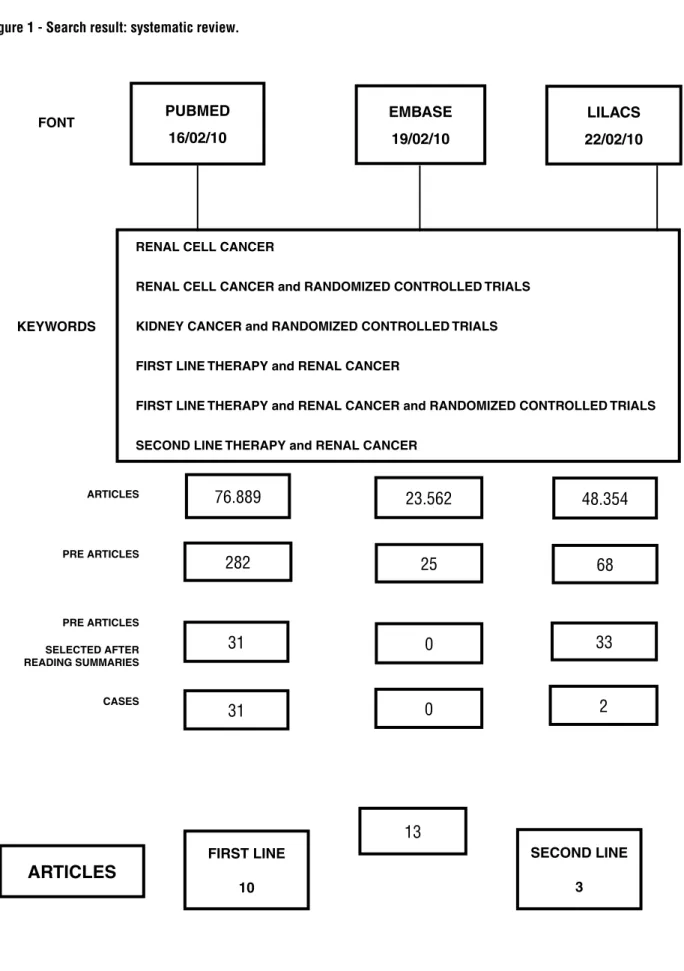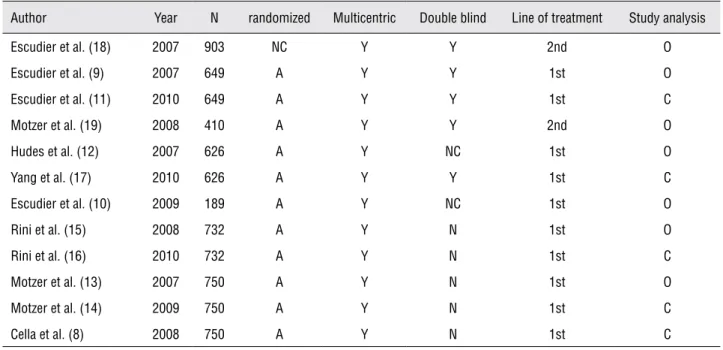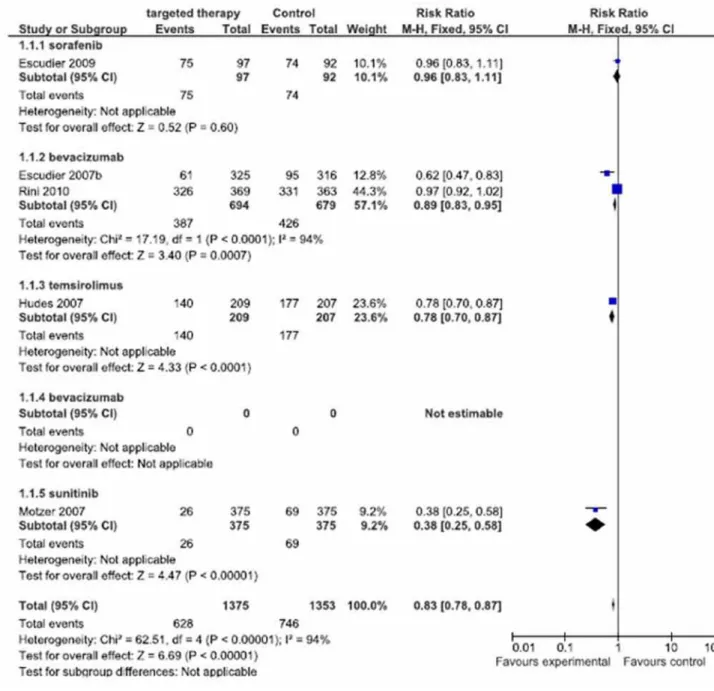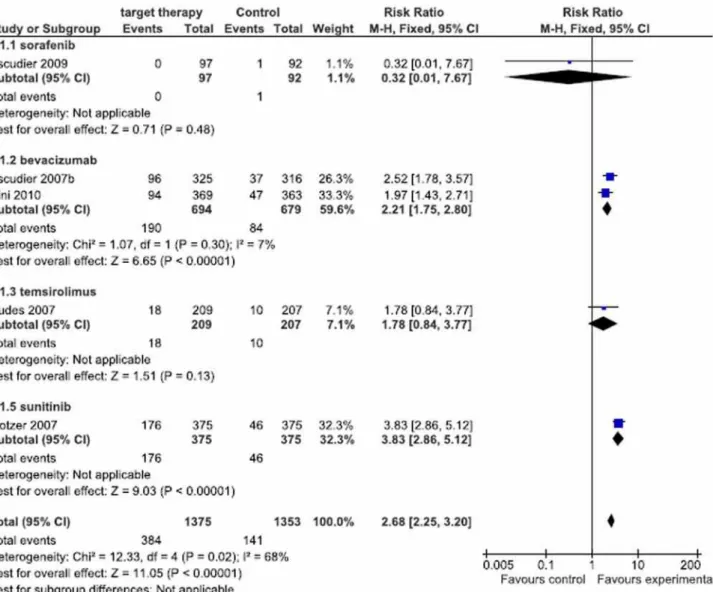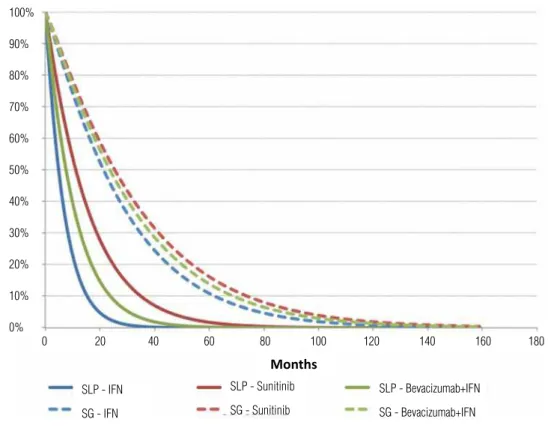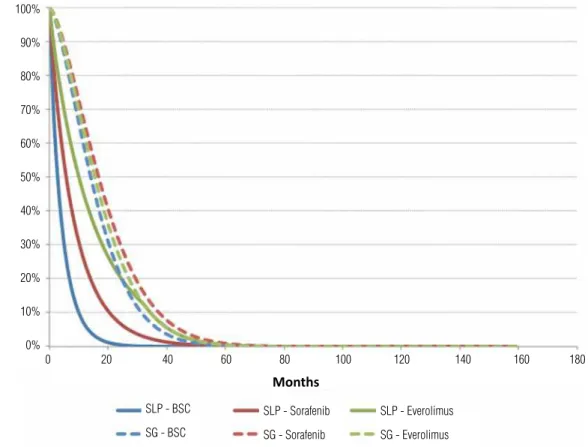Key words:
Kidney Neoplasms; Tissue Therapy; Meta-Analysis as Topic; Review [Publication Type]
Int Braz J Urol. 2013; 39: 768-78
__________________ Submitted for publication: October 19, 2012
__________________ Accepted after revision: September 09, 2013
Objectives: At present there are several drugs for the treatment of advanced renal cell carcinoma (ARCC). The main objective of this work was to perform a systematic review (SR) and meta-analysis (MA) of clinical randomized studies that compared target cell therapies (TCT).
Materials and Methods: SR identified clinical randomized trials that compared TCT versus interferon-alpha in the treatment of patients with ARCC. In order to analyze efficiency, it was evaluated free-survival progression (FSP), total survival (TS) and response rate (RR). Results: In relation to first line treatment, seven studies of TCT were identified using suni-tinib, sorafenib, bevacizumab and temsirolimus; and two studies with sorafenib and eve-rolimus for second line treatment. Relative risk (RRi) of MA for FSP of first line therapies was: 0.83, CI = 0.78-0.87, I2 = 94% and p < 0.00001. Best results of RR of specific FSP among studies were: 0.38, sunitinib, CI = 0.25-0.58, bevacizumab, 0.62, CI = 0.47-0.83; and temsirolimus, 0.78, CI = 0.70-0.87. MA didn’t show any benefit regarding TS of first line treatment of all analyzed drugs. As for RR significant results were: sunitinib, 3.83 CI = 2.86-5.12; bevacizumab, 2.52 CI = 1.78-3.57 and bevacizumab, 1.97 CI = 1.43-2.71. Conclusions: For first line treatment, sunitinib was the most effective TCT in relation to FPS; there was no alteration of TS and RR was small but significant for sunitinib and bevacizumab. Available studies could not conclude any results for second line treatments.
Systematic review and meta-analysis of target terapies
for the treatment of metastatic renal cancer
_______________________________________________
Marcela Durán, Wagner Matheus, Ubirajara Ferreira, Otávio Clark
Faculty of Medical Sciences, Department of Oncological Urology (MD, WM, UF), Universidade Estadual de Campinas and Evidências Credibilidade Científica (OC), Campinas, SP, Brazil
ABSTRACT
ARTICLE
INFO
_________________________________________________________ ___________________
INTRODUCTION
The best treatment for renal tumor is sur-gery, especially when the tumor is located in the kidney with no lymph node involvement or me-tastasis. In advanced renal cell carcinoma (ARCC), being the tumor incurable, most available treat-ments are palliative and the patients usually die. In those cases, the objective is to increase total survival (TS), free survival progression (FSP), res-ponse rate (RR) and quality of life (QF) of patients. Before target cell therapies (TCT) became available, interleucin-2 (IL2) and interferon-alpha
(IFN-α) were the main used therapies for this dise-ase, with low response, from 5% to 20% (1-4). At present, TCT include sorafenib, sunitinib, bevaci-zumab, temsirolimus and everolimus.
Sorafenib and sunitinib are oral inhibitors of tirosine-kinases. Sorafenib inhibits endothelial growth receptors (VEGF) and platelet-derived gro-wth factors (PDGF). Sunitinib inhibits VEGF 1, 2 and 3 with antitumor and anticoagulant effects.
Temsirolimus is an inhibitor of rapamicin--kinase (mTOR) with antiangiogenic effect, as well as everolimus. Everolimus is used orally.
MATERIAL AND METHODS
Systematic review (SR) was made by se-arch of clinical randomized trials (CRT) that used TCT to treat ARCC compared to IFN-α as first and second lines of treatment.
The search was made at the databases EM-BASE, LILACS, MEDLINE, The Cochrane Control-led Trials Register, Cochrane Database of Systema-tic Reviews and Cochrane Clinical Trials.
Other sources included American Society of Clinical Oncology, European Society of Medical Oncology, Brazilian Society of Clinical Oncolo-gy, Cancer Brazilian Society, American Society of Urology and Brazilian Urological Society.
The following key words were used for the search:
(“Kidney Neoplasms” [Mesh] OR kidney cancer OR renal carcinoma) AND (“Randomized Controlled Trial” [Publication Type] OR random* OR single blind OR double blind “First Line The-rapy and Renal Cancer”) AND (“First Line Thera-py and Renal Cancer and Randomized Controlled Trials” [Mesh]) AND (“Second Line Therapy and Renal Cancer and Randomized”) [MESH].
The selected studies were realized from Ja-nuary 2000 to December 2011, in English, Spanish or Portuguese.
The obtained summaries were evaluated by two independent reviewers and those who ful-filled the select criteria were pre-selected. When both reviewers disagreed, the article(s) was (re) re-viewed by a third reviewer.
The inclusion criteria were: multicentric randomized double-blind studies that compared TCT with IFN-α. All studies that did not meet tho-se criteria were excluded and thotho-se in duplicity were considered only one time.
The studies were identified by the reviewers by the first author’s name and year of publishing. All data were directly obtained from the studies or calculated based on the available information: epidemiological data, methods and results, inclu-ding FSP, TS and RR. Bias methodological aspects
(5) were also analyzed, including randomization methods, double-blind aspects, intention of treat-ment, loss of patients, sample size, multicentricity and study sponsors.
Statistic analysis was based on the null hypothesis that TCT does not change the results of the treatment. It was used the software Review Manager 5.1 (Cochrane Collaboration Software) (6). In the hypothesis test the level of significance was α = 0.05 for the rejection of the null hypothe-sis, in a two-tailed test.
META-ANALYSIS
Meta-analysis of the quantitative variables related to TS, FSP and RR were done by Relative Risk (RRi) (6).
HETEROGENEITY ANALYSIS
In the present study we used the hetero-geneity index I2 based on the chi-square test
cal-culus (7). When it was observed heterogeneity at meta-analysis with I2 > 70% the reason was
rese-arched (5) using new analysis excluding discre-pant studies in order to obtain new heterogeneity indexes (5).
RESULTS
Systematic Review
After the search using the selected key wor-ds and databases, 148.805 studies were initially se-lected, related to renal cancer. In order to select those randomized studies that used TCT, new key words were applied and it was obtained 375 refe-rences. Among these, after analysis of the sum-mary, 33 were selected to detailed analysis of the complete article and 21 were excluded (Figure-1).
Figure 1 - Search result: systematic review.
FONT
PUBMED 16/02/10
RENAL CELL CANCER
RENAL CELL CANCER and RANDOMIZED CONTROLLED TRIALS
KIDNEY CANCER and RANDOMIZED CONTROLLED TRIALS
FIRST LINE THERAPY and RENAL CANCER
FIRST LINE THERAPY and RENAL CANCER and RANDOMIZED CONTROLLED TRIALS
SECOND LINE THERAPY and RENAL CANCER EMBASE
19/02/10
LILACS 22/02/10
KEYWORDS
ARTICLES 76.889
23.562 48.354
25 68
0 33
0
13
2 282
31
31
ARTICLES
FIRST LINE
10
SECOND LINE
3 PRE ARTICLES
PRE ARTICLES
SELECTED AFTER READING SUMMARIES
Most patients of those studies, although with different selection criteria, had the following characteristics: age greater than 18 years old, me-tastatic renal clear-cells tumor, no previous syste-mic therapy, good medullar response, good hepa-tic and renal function, good condition, ECOG (0-1) or Karnofsky ≥ 60 or 70%. Patients with metasta-sis, radicular compression, uncontrolled systemic hypertension, pregnancy and uncontrolled thyroid diseases were not included.
Quality of the Studies
The evaluated studies were heterogeneous and most were sponsored by the laboratories ma-nufacturers. Most were randomized studies, dou-ble-blind and multicentric. The studies were clas-sified as originals or complementary: the originals are initial studies of analysis of first publication (interim analysis) and the complementary when final analysis was described in a posterior publi-cation (Table-1).
META-ANALYSIS
Not all selected studies were evaluated at meta-analysis due to the selected end points. Only
seven articles of first line treatment and two of se-cond line were evaluated.
Free Survival Progression (FSP)
Regarding FSP, meta-analysis used 1375 treated patients with target cell therapies (first line treatment) versus 1353 treated patients with inter-feron-alpha (control group). Among these patients, 628 progressed in group TCT and 746 in control group (Figure-2).
Meta-analysis showed RRi of 0.83, IC=0.78-0.87, I2= 94% and p < 0.00001, and the best
parame-ters were observed of the sunitinib study with RRi of 0.38, CI = 0.25-0.58 (Motzer et al., 2007 (13)), follo-wed by the bevacizumab study with RRi of 0.62, CI = 0.47-0.83 (Escudier et al., 2007 (9)) and tem-sirolimus, RRi of 0.78 CI = 0.70-0.87 (Hudes et al., 2007 (12)). Worse results were from the study with bevacizumab, with RRi of 0.97, CI = 0.92-1.02 (Rini et al., 2010 (16)) and the study of sorafenib, with RRi of 0.96 CI = 0.83-1.11 (Escudier et al., 2009(10)).
Total Survival
Four studies evaluated TS. Rini 2010 (16) did not inform how many patients survived or died in each arm, and the study was excluded at final
Table 1 - Metodological characteristics of the included studies.
Author Year N randomized Multicentric Double blind Line of treatment Study analysis Escudier et al. (18) 2007 903 NC Y Y 2nd O Escudier et al. (9) 2007 649 A Y Y 1st O Escudier et al. (11) 2010 649 A Y Y 1st C Motzer et al. (19) 2008 410 A Y Y 2nd O Hudes et al. (12) 2007 626 A Y NC 1st O Yang et al. (17) 2010 626 A Y Y 1st C Escudier et al. (10) 2009 189 A Y NC 1st O Rini et al. (15) 2008 732 A Y N 1st O Rini et al. (16) 2010 732 A Y N 1st C Motzer et al. (13) 2007 750 A Y N 1st O Motzer et al. (14) 2009 750 A Y N 1st C Cella et al. (8) 2008 750 A Y N 1st C
Figure 2 - Meta-analysis of free survival progression.
analysis. Among the considered studies, it was eva-luated TS of 1007 patients treated with TCT and 990 with interferon-alpha, and 422 and 443 died respectively (Figure-3).
Meta-analysis RRi of TS was 0.94, CI = 0.86-1.02, I2 of 0% and p = 0.14. The values of
RRi of each study were: sorafenib: RRi 0.63 CI = 0.23-1.71 (Escudier et al., 2009 (10)), bevacizumab: RRi 0.95 CI = 0.86-1.06 (Escudier et al., 2007 (9)),
sunitinib: RRi 0.95 CI = 0.83-1.09 (Motzer et al., 2007 (13)) and temsirolimus: RRi 0.59 CI = 0.22-1.61 (Hudes et al., 2007 (12)).
Respost Rate
RRi obtained using meta-analysis of the studies was 2.68 CI = 2.25-3.20, I2 68% and p <
0.00001. Best RR result was obtained with suniti-nib (Motzer et al., 2007 (13)) with RRi of 3,83 and CI = 2.86-5.12. Following, according to favorable responses: bevacizumab, RRi 2.52 CI = 1.78-3.57 (Escudier et al., 2007 (9)), bevacizumab, RRi 1.97 CI = 1.43-2.71 (Rini et al., 2010 (16)), temsirolimus, RRi 1.78 CI = 0.84-3.77 (Hudes, et al., 2007 (12)) and finally sorafenib, RRi 0.32 CI = 0.01-7.62 (Es-cudier et al., 2009 (10)).
Heterogeneity (I2)
Due to the high level of I2 = 94% at
meta--analysis of FPS and of I2 = 68% at objective RR,
several analysis were made excluding each work of the respective meta-analysis. TS meta-analysis showed I² = 0%, so the analysis of heterogeneity was unnecessary.
During FSP analysis the maximum value obtained for heterogeneity was observed when the study of Rini et al (2010 (16) was excluded: I2 = 89%,
showing great heterogeneity among the studies. Af-ter excluding the study of Motzer et al., 2007 (13) during RR analysis heterogeneity value was I2 = 0%.
Second line studies
It was not possible to perform meta-analy-sis, since populations of both studies were qui-te different. One of the studies included patients
Figure 4 - Meta-analysis of Response Rate.
previously treated with systemic therapy and the other patients treated previously with sunitinib, sorafenib or both (Escudier et al., 2007 (18) and Motzer et al., 2008 (19),respectively).
SURVIVAL CURVES
FSP curves of first line treatments showed little improvement, in order of importance, with the use of sunitinib, bevacizumab and
interferon--alpha. TS curves were very similar and with no statistical differences (Figure-5).
In relation to first line treatments of high risk patients, FSP and TS curves showed a little better improvement with temsirolimus, compared to interferon-alpha (Figure-6).
Figure 5 - Free survival progression and total survival curves for first line treatment.
Figure 6 - Free survival progression and total survival curves for first line treatment of high risk patients.
100%
90%
80%
70%
60%
50%
40%
30%
20%
10%
0%
100%
90%
80%
70%
60%
50%
40%
30%
20%
10%
0%
0 20 40 60 80 100 120 140 160 180
0 20 40 60 80 100 120 140 160 180 SLP - IFN
SG - IFN
SLP - IFN
SG - IFN SLP - Sunitinib
SG - Sunitinib
Months
Months
SLP - Temsirolimus
SG - Temsirolimus
SLP - Bevacizumab+IFN
SG - Bevacizumab+IFN
% PROGRESSION FREE SURVIV
AL
% PROGRESSION FREE SURVIV
sorafenib and finally only palliative care (BSC) (Figure-7). As previously related, second line tre-atments were very heterogeneous and it was not possible to perform meta-analysis.
DISCUSSION
The lack of suitable studies that evaluate efficiency of target cell therapies (TCT) for advan-ced renal cell carcinoma (ARCC) was noted during systematic review and only a few were submitted to meta-analysis: seven first line treatments and two second line treatments.
It was also observed difficulty to collect data from the studies, since some presented not clear and non-objective results. Among the revised studies, there were several difficulties regarding interpretation of results, such as randomization, quantification of response rate, number of deaths during the study, that impaired TS calculus.
Many selected works were excluded sin-ce they were not prospective and with a control group, randomized and with the necessary infor-mation for analysis. Subgroup analysis studies were also excluded as well as those with duplica-ted populations.
At present, there are several available treatments with TCT, as well as with pazopanib (21,22), axitinib (23) and tivozamib (24). However, only studies that used sorafenib, sunitinib, beva-cizumab, temsirolimus and everolimus were inclu-ded for comparision with interferon-alpha.
Meta-analysis of FSP showed RRi with a slight favoring for the treatment with TCT compa-red to control group treated with IFN-α (RRi 0,83 CI = 0.78 - 0.87). However, two aspects must be pointed out. First, better result of RRi sunitinib (RR 0.38 CI = 0.25 - 0.58 (13)) compared to other dru-gs, showing better efficacy of this drug as first line treatment. Second, bevacizumab studies showed
Figure 7 - Free survival progression and total survival curves for second line treatment.
% PROGRESSION FREE SURVIV
AL
100%
90%
80%
70%
60%
50%
40%
30%
20%
10%
0%
0 20 40 60 80 100 120 140 160 180
SLP - BSC
SG - BSC
SLP - Sorafenib
SG - Sorafenib
SLP - Everolimus
SG - Everolimus
different and controvertial results (Escudier et al., 2007 (9) and Rini et al., 2010 (16)), with different Rris and CIs: RR 0.62 CI = 0.47 - 0.83 and RR 0.97 CI = 0.92 - 1.02, respectively.
RRi values of TS of the sorafenib studies (Escudier et al., 2009 (11)), bevacizumab (Escudier et al., 2007 (9)), sunitinib (Motzer et al., 2007 (13)) and temsirolimus (Hudes et al., 2007 (12)) did not indicate significant differences of TS RRi of patients of control group, confirmed by the value of I² = 0.
In relation to RR meta-analysis, treat-ment with sunitinib was superior (RR 3.83 and CI [2.86-5.12]), compared to other drugs. This diffe-rence was so bigger that, when the heterogeneous analysis was performed, the initial I² was 68% and became 0% after the exclusion of that paper (Mot-zer et al., 2007 (13)).
All simulations of heterogeneity analysis of FSP showed high I² (> 50%) demonstrating that the five first line treatment studies are not homo-geneous. The differences may be related to varied results of efficiency of the four drugs, population characteristics and methodologies. It was not pos-sible to prove that the five studies presented ho-mogeneously results of FSP. In the future, further studies are necessary with a bigger and more ho-mogeneous population.
CONCLUSIONS
For first line treatment, sunitinib is the most efficient therapy regarding FSP; the studies did not show any improvement of TS and RR was low, but significant, using sunitinib and bevaci-zumab. Available studies could not conclude the use as second line therapies. Those results must be carefully analyzed due to the small number of available studies.
CONFLICT OF INTEREST
None declared.
REFERENCES
1. Fisher RI, Rosenberg SA, Fyfe G: Long-term survival update for high-dose recombinant interleukin-2 in patients with renal cell carcinoma. Cancer J Sci Am. 2000; 6(Suppl 1): S55-7.
2. McDermott DF, Regan MM, Clark JI, Flaherty LE, Weiss GR, Logan TF, et al.: Randomized phase III trial of high-dose interleukin-2 versus subcutaneous interleukin-2 and inter-feron in patients withmetastatic renal cell carcinoma. J Clin Oncol. 2005; 23: 133-41. Erratum in: J Clin Oncol. 2005; 23: 2877.
3. Motzer RJ, Murphy BA, Bacik J, Schwartz LH, Nanus DM, Mariani T, et al.: Phase III trial of interferon alfa-2a with or without 13-cis-retinoic acid for patients with advanced renal cell carcinoma. J Clin Oncol. 2000; 18: 2972-80. 4. Yang JC, Sherry RM, Steinberg SM, Topalian SL,
Schwartz-entruber DJ, Hwu P, et al.: Randomized study of high-dose and low-dose interleukin-2 in patients with metastatic renal cancer. J Clin Oncol. 2003; 21: 3127-32.
5. Higgins JPT, Green S. Cochrane Handbook for Systematic Reviews of Interventions Version 5.0.2 [updated Septem-ber 2009]: The Cochrane Collaboration; 2008. Available at: www.cochrane-handbook.org
6. The Nordic Cochrane Centre. Review Manager (RevMan) [Computer program]. Version 5.0. Copenhagen: The Co-chrane Collaboration; 2008. Available at: http://ims.co-chrane.org/home
7. Higgins JP, Thompson SG, Deeks JJ, Altman DG: Measur-ing inconsistency in meta-analyses. BMJ. 2003; 327: 557-60.
8. Cella D, Li JZ, Cappelleri JC, Bushmakin A, Charbonneau C, Kim ST, et al.: Quality of life in patients with metastatic renal cell carcinoma treated with sunitinib or interferon alfa: results from a phase III randomized trial. J Clin Oncol. 2008; 26: 3763-9.
9. Escudier B, Pluzanska A, Koralewski P, Ravaud A, Bracarda S, Szczylik C, et al.: Bevacizumab plus interferon alfa-2a for treatment of metastatic renal cell carcinoma: a randomised, double-blind phase III trial. Lancet. 2007; 370: 2103-11. 10. Escudier B, Szczylik C, Hutson TE, Demkow T, Staehler M,
Rolland F, et al.: Randomized phase II trial of first-line treat-ment with sorafenib versus interferon Alfa-2a in patients with metastatic renal cell carcinoma. J Clin Oncol. 2009; 27: 1280-9. Erratum in: J Clin Oncol. 2009; 27: 2305. 11. Escudier B, Bellmunt J, Négrier S, Bajetta E, Melichar B,
Bracarda S, et al.: Phase III trial of bevacizumab plus in-terferon alfa-2a in patients with metastatic renal cell car-cinoma (AVOREN): final analysisof overall survival. J Clin Oncol. 2010; 28: 2144-50.
12. Hudes G, Carducci M, Tomczak P, Dutcher J, Figlin R, Ka-poor A, et al.: Temsirolimus, interferon alfa, or both for advanced renal-cell carcinoma. N Engl J Med. 2007; 356: 2271-81.
14. Motzer RJ, Hutson TE, Tomczak P, Michaelson MD, Bu-kowski RM, Oudard S, et al.: Overall survival and updated results for sunitinib compared with interferon alfa in pa-tients with metastatic renal cellcarcinoma. J Clin Oncol. 2009; 27: 3584-90.
15. Rini BI, Halabi S, Rosenberg JE, Stadler WM, Vaena DA, Ou SS, et al.: Bevacizumab plus interferon alfa compared with interferon alfa monotherapy in patients with metastatic renal cell carcinoma: CALGB 90206. J Clin Oncol. 2008; 26: 5422-8. 16. Rini BI, Halabi S, Rosenberg JE, Stadler WM, Vaena DA,
Archer L, et al.: Phase III trial of bevacizumab plus inter-feron alfa versus interinter-feron alfa monotherapy in patients with metastatic renal cellcarcinoma: final results of CALGB 90206. J Clin Oncol. 2010; 28: 2137-43.
17. Yang S, de Souza P, Alemao E, Purvis J: Quality of life in patients with advanced renal cell carcinoma treated with temsirolimus or interferon-alpha. Br J Cancer. 2010; 102: 1456-60.
18. Escudier B, Eisen T, Stadler WM, Szczylik C, Oudard S, Siebels M, et al.: Sorafenib in advanced clear-cell renal-cell carcinoma. N Engl J Med. 2007; 356: 125-34. Erratum in: N Engl J Med. 2007; 357: 203.
19. Motzer RJ, Escudier B, Oudard S, Hutson TE, Porta C, Bra-carda S, et al.: Efficacy of everolimus in advanced renal cell carcinoma: a double-blind, randomised, placebo-controlled phase III trial. Lancet. 2008; 372: 449-56.
20. Bukowski R, Cella D, Gondek K, Escudier B; Sorafenib TAR-GETs Clinical Trial Group. Effects of sorafenib on symp-toms and quality of life: results from a large randomized placebo-controlled study in renalcancer. Am J Clin Oncol. 2007; 30: 220-7.
21. Sternberg CN, Davis ID, Mardiak J, Szczylik C, Lee E, Wag-staff J, et al.: Pazopanib in locally advanced or metastatic renal cell carcinoma: results of a randomized phase III trial. J Clin Oncol. 2010; 28: 1061-8.
22. Rexer H: First-line therapy of advanced or metastasized re-nal cell cancer: open randomized phase III sequence study to examine the effectiveness and tolerance of sorafenib followed by pazopanib versus pazopanib followed by sorafenib in the first-line treatment of patients with ad-vanced or metastasized renal cell cancer (SWITCH-2 - AN 33/11)]. Urologe A. 2012; 51: 724-6.
23. Rini BI, Escudier B, Tomczak P, Kaprin A, Szczylik C, Hut-son TE, et al.: Comparative effectiveness of axitinib versus sorafenib in advanced renal cell carcinoma (AXIS): a ran-domised phase 3 trial. Lancet. 2011; 378: 1931-9. Erratum in: Lancet. 2012; 380: 1818.
24. Nosov DA, Esteves B, Lipatov ON, Lyulko AA, Anischen-ko AA, ChacAnischen-ko RT, et al.: Antitumor activity and safety of tivozanib (AV-951) in a phase II randomized discontinua-tion trial in patients with renal cellcarcinoma. J Clin Oncol. 2012; 30: 1678-85.
